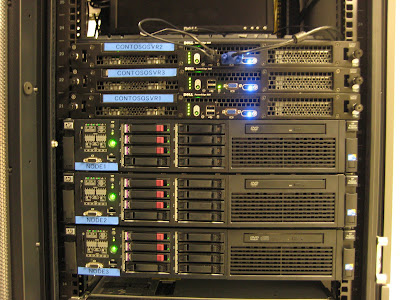Here is the Part 3 of Building VDI using Remote Desktop Services (RDS). For those who has missed Part 2, please click on this link :-
http://www.ms4u.info/2010/03/part-2-building-vdi-using-remote.html
Continue from Part 2. This part will focus on Guest VM configuration.
After the virtual machines are installed and configured for the ms4u.info domain, you must configure them to work with Remote Desktop Services. The following steps must be configured on each virtual machine:
• Enable Remote Desktop.
• Add the user accounts that will be using this virtual machine to the local Remote Desktop Users security group.
• Allow Remote RPC.
• Create a firewall exception to allow Remote Services Management.
• Add permissions to the RDP protocol.
Task 1: Enable Remote Desktop and Add VDIGroup to the local Remote Desktop Users group
1. Log on to VDI01-Win7 with administrative rights.
2. Click Start, right-click Computer, and then click Properties.
3. Click Remote settings.
4. Under Remote Desktop, click Allow connections only from computers using Remote Desktop with Network Level Authentication (more secure), and then click Apply
5. Click on select Users button
6. On the Remote Desktop Users, click Add
7. Enter VDIGroup and click Check name
8. Click OK button to close the Remote Desktop Users
9. Click OK button to close the System Properties
10. Repeat these steps for VDI02-Win7 and VDI03-Win7.
Task 2:- To allow Remote RPC for Remote Desktop Services
1. Log on to VDI01-Win7 with administrative right
2 Click Start, and in the Search programs and files box, type regedit.exe and then press ENTER.
3. Navigate to HKEY_LOCAL_MACHINE\SYSTEM\CurrentControlSet\Control\TerminalServer.
4. Double-click the AllowRemoteRPC registry entry, in the Value data box, type 1 and then click OK.
Default value is 0.
5. Close Registry Editor.
6. Repeat these steps for VD102-Win7 and VDI03-Win7.
Task 3- To enable the Remote Service Management Windows Firewall exception
1. Log on to VDI01-Win7 with administrative right
2. Click Start, click Control Panel, and then click System and Security.
3. Under the Windows Firewall heading, click Allow a program through Windows Firewall.
4. Select the
Remote Service Management check box, and then click OK.
5. Repeat these steps for VDI02-Win7 and VDI03-Win7.
Task 4-To add RDP protocol permissions to a virtual machine
1. Log on to VDI01-Win7 with administrative right
2. Click Start, point to All Programs, and then click Accessories.
3. Right-click Command Prompt, and then click Run as administrator.
4. If the User Account Control dialog box appears, confirm that the action it displays is what you want, and then click Yes.
5. At the command prompt, type the following commands:
• wmic /node:localhost RDPERMISSIONS where TerminalName="RDP-Tcp" CALL AddAccount "ms4u\RDSVH$",1
• wmic /node:localhost RDACCOUNT where "(TerminalName='RDP-Tcp' or TerminalName='Console') and AccountName='ms4u\\RDSVH$'" CALL ModifyPermissions 0,1
• wmic /node:localhost RDACCOUNT where "(TerminalName='RDP-Tcp' or TerminalName='Console') and AccountName='ms4u\\RDSVH$'" CALL ModifyPermissions 2,1
• wmic /node:localhost RDACCOUNT where "(TerminalName='RDP-Tcp' or TerminalName='Console') and AccountName='ms4u\\RDSVH$'" CALL ModifyPermissions 9,1
• Net stop termservice
• Net start termservice
Note:-
Replace "ms4u" according to your domain name & "RDSVH" to your RD Virtualization Server host name.
6. Log off VDP1-CLNT. This is required in order for VDI Users to log on to one of the virtual machines in the virtual desktop pool successfully.
7. Repeat these steps for VDI02-Win7 and VDI03-Win7
Task 5- Enable Rollback on a virtual machine
Once you've complete all the configuration, you need to enable rollback. This allow VM to revert to original state once the user has log off. No data is saved into the VM. Please do not save your data inside the VM.
1. Open Hyper-V Manager. To open Hyper-V Manager, click Start, point to Administrative Tools, and then click Hyper-V Manager.
2. Under Virtual Machines, right-click VDI01-Win7.ms4u.info, and then click Snapshot.
3. Under Snapshots, right-click VDI01-Win7.ms4u.info, and then click Rename.
4. Type
RDV_Rollback and then press ENTER. (Must use the exact snapshot name)
5.Cose Hyper-V Manager.
6. Repeat these steps for the VDI02-Win7 and VDI03-Win7 virtual machine
Task 6 - Verify Remote Desktop
1. Use your client computer and Open Re mote desktop connection. Click Start , on the search program and files , enter "mstsc" and press Enter
2. Key in "VDI01-Win7" and click Connect
3. Provide security authentication by enter username: -ms4u\vdiuser1 and the password is
P@ssw0rd.
4. Click Ok
5. Make sure you can log on to the VM. Log off and repeat these steps for VDI02-Win7 and VDI03-Win7.
Stay tuned for Part 4:- Building VDI using Remote Desktop Services (RDS) -
Click here















